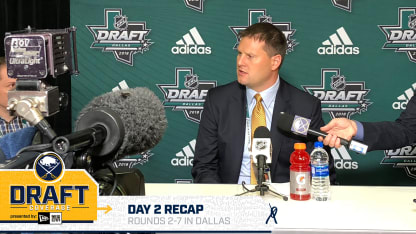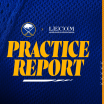"Not at all, really," assistant general manager Randy Sexton said. "We don't draft by region, we don't draft by country. We scour the world for the best players that we can find that play a style that we want to play going forward and then we work very diligently to learn as much as we can about them as human beings so that they map to our character criteria. Then we put them in the order that we think makes the most sense based on their probability to become a Sabre."
Pick-by-pick breakdown of Day 2 | READ: Pekar 'never imagined' being drafted | Complete Draft coverage
Sexton said the Sabres seek to draft the best player available rather than fill certain positional needs. In this case, it just so happened that the players atop Buffalo's list happened to be defensemen more often than not, and Jason Botterill was more than happy to replenish the cupboard on the back end.
"You can never have too many defensemen," Botterill said. "It was something that we did talk a lot about, about trying to add more defensemen. We certainly knew who we were going to take at number one.
"… The way we want to play, you look at our pipeline right now, I think it's a scenario where we need to add more defensemen to our group. So, we're very happy with how the day turned out."
Dahlin now headlines Buffalo's prospect group on the backend, which also includes Brendan Guhle, who should challenge for a roster spot in Buffalo next season, as well as Will Borgen in Rochester and Casey Fitzgerald at the collegiate level. Botterill acquired another defense prospect when he traded for Brandon Hickey last week.
"Obviously, we're very excited about developing a young player like Brendan Guhle," Botterill said. "You've seen some of our decisions, to get a player like Hickey. We're excited about a player like Fitzgerald, who's in our organization too. So as excited as we are about Brendan Guhle, we want to make sure there's more Brendan Guhles coming. That was one of the emphases for us."
Now, you can add Mattias Samuelsson, Linus Lindstrand Cronholm, Miska Kukkonen and William Worge Kreü to that list. Buffalo's draft actually followed a larger trend; 70 defensemen were taken, more than any other position. There were 28 Swedes drafted, tying a record set in 2011.
"They've done an outstanding job as a country in the development process," Botterill said. "Especially on the backend, the mobility, how a lot of NHL teams now are is how Swedish players played growing up. Good mobility, good hockey sense, they know how to move the puck. Those are attributes that we're looking for in our organization."
Here are more notes and observations from Day 2 of the draft.



















